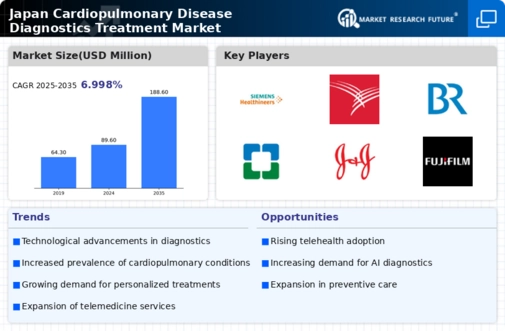Rising Awareness and Education
There is a growing awareness and education regarding cardiopulmonary diseases among the Japanese population, which significantly impacts the cardiopulmonary disease-diagnostics-treatment market. Public health campaigns and educational programs have been instrumental in informing individuals about the risks associated with cardiopulmonary conditions. This heightened awareness encourages early diagnosis and treatment, leading to increased demand for diagnostic services and therapeutic interventions. Moreover, as patients become more informed about their health, they are more likely to seek medical advice and undergo regular screenings. This trend is expected to drive the cardiopulmonary disease-diagnostics-treatment market, as healthcare providers respond to the increasing need for accessible and effective diagnostic and treatment options.
Increased Healthcare Expenditure
Japan's healthcare expenditure has been on an upward trajectory, which serves as a substantial driver for the cardiopulmonary disease-diagnostics-treatment market. The government allocates a significant portion of its budget to healthcare, with spending reaching approximately 10% of GDP. This financial commitment facilitates the development and adoption of advanced diagnostic technologies and treatment modalities. As healthcare budgets expand, hospitals and clinics are more likely to invest in state-of-the-art equipment and training for healthcare professionals. This trend not only enhances the quality of care but also increases the accessibility of cardiopulmonary disease diagnostics and treatments. Consequently, the cardiopulmonary disease-diagnostics-treatment market is poised for growth as healthcare providers seek to improve patient outcomes through innovative solutions.
Aging Population and Rising Incidence
The aging population in Japan is a critical driver for the cardiopulmonary disease-diagnostics-treatment market. As individuals age, the prevalence of cardiopulmonary diseases tends to increase, leading to a higher demand for diagnostic and treatment solutions. According to recent statistics, approximately 30% of the Japanese population is over 65 years old, which correlates with a rise in conditions such as chronic obstructive pulmonary disease (COPD) and heart failure. This demographic shift necessitates advanced diagnostic tools and effective treatment options, thereby propelling market growth. Furthermore, the increasing awareness of cardiopulmonary health among the elderly is likely to enhance the utilization of healthcare services, further stimulating the cardiopulmonary disease-diagnostics-treatment market. The combination of an aging population and the associated health challenges presents a significant opportunity for market expansion.
Regulatory Support and Policy Framework
The regulatory environment in Japan plays a pivotal role in shaping the cardiopulmonary disease-diagnostics-treatment market. The government has established policies that promote research and development in medical technologies, which is crucial for advancing diagnostic and treatment options. Regulatory bodies are actively working to streamline the approval processes for new medical devices and treatments, thereby encouraging innovation. This supportive framework not only fosters the introduction of cutting-edge solutions but also enhances market competitiveness. As regulations evolve to accommodate new technologies, the cardiopulmonary disease-diagnostics-treatment market is likely to experience accelerated growth, driven by the influx of innovative products and services that meet the needs of healthcare providers and patients alike.
Technological Integration in Healthcare
The integration of advanced technologies in healthcare is transforming the cardiopulmonary disease-diagnostics-treatment market. Innovations such as telemedicine, artificial intelligence, and wearable health monitoring devices are enhancing the efficiency and accuracy of diagnostics and treatment. For instance, telemedicine allows for remote consultations, making it easier for patients to access specialists without geographical constraints. Additionally, AI-driven diagnostic tools can analyze patient data more rapidly and accurately, leading to timely interventions. The adoption of these technologies is likely to improve patient outcomes and streamline healthcare processes, thereby driving growth in the cardiopulmonary disease-diagnostics-treatment market. As technology continues to evolve, its impact on diagnostics and treatment will become increasingly pronounced.






















Leave a Comment